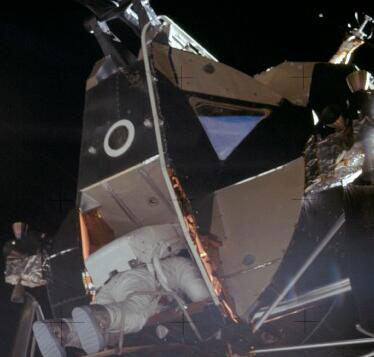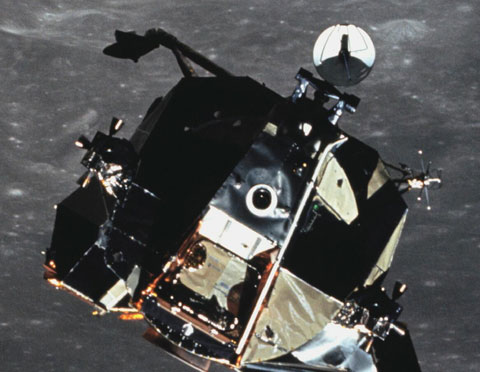|
Author
|
Topic: Apollo 11: Ascent stage structrual buckling
|
GACspaceguy
Member Posts: 2516
From: Guyton, GA
Registered: Jan 2006
|
 posted 04-05-2009 10:37 AM
posted 04-05-2009 10:37 AM
   
While reviewing photos of the Apollo 11 I saw something I had not noticed before. The forward panels on the LM showed significant buckling. Take a look at this photo prior to decent. On the surface in the photo below there in no distortion in the panels.  The significant photo is the next one as it shows the forward skins buckled above and beside the forward hatch.  I know that on the aft section of Apollo 16 on accent the panels came loose but did not know of other buckling. Did this happen on all flights? What was the max g force on lift off that would have caused this structural deformation? |
spacecraft films
Member Posts: 802
From: Columbus, OH USA
Registered: Jun 2002
|
 posted 04-05-2009 10:50 AM
posted 04-05-2009 10:50 AM
   
Keep in mind that these outside panels are only thermal protection panels, connected to an exterior frame. The pressure vessel and main structure is a separate part of the vehicle. So these deformations are not a problem, even when the entire aft portion collapsed on Apollo 16.You do see this on other flights. In fact if you look closely at docking sequences you can see the panels rippling from impingement by the CSM reaction control thrusters as the vehicles come together. |
GACspaceguy
Member Posts: 2516
From: Guyton, GA
Registered: Jan 2006
|
 posted 04-05-2009 11:27 AM
posted 04-05-2009 11:27 AM
   
Thanks for the info and understand the function of the “skin”. It is just that these panels must connect to the actual load bearing structure at some point. In order for the exterior panels to take a permanent set, as is shown in the accent photo, there must have been some distortion in structure to allow the associated buckles. |
mjanovec
Member Posts: 3811
From: Midwest, USA
Registered: Jul 2005
|
 posted 04-05-2009 12:22 PM
posted 04-05-2009 12:22 PM
   
Some structures are designed to flex under stresses...just like the wing of a commercial airliner flexes under stress. So it stands to reason the structure the LM outer panels are attached to is probably going to flex somewhat while under the stress of lunar liftoff. Since those panels were pretty fragile, they easy show the results of the stresses applied to the LM. However, since the LM was only designed for one flight, that amount was damage is acceptable. |
ilbasso
Member Posts: 1522
From: Greensboro, NC USA
Registered: Feb 2006
|
 posted 04-05-2009 02:05 PM
posted 04-05-2009 02:05 PM
   
Great observation about the buckled skin! My hypothesis is that the stresses that caused the buckling were entirely due to ignition of the ascent engine. You can clearly see that happening to the back of the Apollo 16 ascent module on the TV image from the Rover when they fire the ascent engine. That moment would be the one time when a sudden kick was delivered to the LM. The descent engine ignition started at 20% thrust, if I recall correctly, so it was less of a jolt than firing the ascent engine. And when the LM landed, the honeycomb in the leg struts absorbed most of the shock from impact with the surface. The skin is just there for micrometeroid and thermal shielding. There was no need for it to have structural integrity. |
Rick Mulheirn
Member Posts: 4208
From: England
Registered: Feb 2001
|
 posted 04-05-2009 02:12 PM
posted 04-05-2009 02:12 PM
   
I suspect the lighting conditions, particularly on the rendezvous third photo, play a significant part in showing the apparent buckling.If you take a look at the superb photo of the LEM at KSC posted by Ed Hengeveld over the weekend, there appears to be some irregularity in the skin of the LM in these areas. The strong light and evident shadows on photo 3 contrasts with the lighting in the first 2 images... in which the illumintaion is flatter reflected light. IMHO the skin irregularities where there before Apollo 11 even left the ground. |
GACspaceguy
Member Posts: 2516
From: Guyton, GA
Registered: Jan 2006
|
 posted 04-05-2009 02:44 PM
posted 04-05-2009 02:44 PM
   
Understand that all structure is elastic and will flex within their elastic limit and not deform. After that it will still take load into their plastic region until they reach their designed ultimate load and failure. What I would have thought was that the structure would move elastically when the lift off load is applied and then once the acceleration finished the structure would return to it original form. The fact that it kept the deformation would indicate that some of the attach structure moved. I understand that the LM was disposable and as long as it served its intended purpose it was OK. I just had never noticed it before. |
LCDR Scott Schneeweis
New Member Posts:
From:
Registered:
|
 posted 04-06-2009 11:07 AM
posted 04-06-2009 11:07 AM
   
quote:
Originally posted by GACspaceguy:
The fact that it kept the deformation would indicate that some of the attach structure moved.
Maybe exceeded its modulus of elasticity and/or could be the result of thermal contraction ...the cabin was a semimonocoque structure with two different alloys 2219 and 7075-T6 employed for the longerons and sheet metal. Dissimilar TCE between the alloy's might have come into play. ------------------
Scott Schneeweis
http://www.SPACEAHOLIC.com/ |
mercsim
Member Posts: 219
From: Phoenix, AZ
Registered: Feb 2007
|
 posted 04-06-2009 02:36 PM
posted 04-06-2009 02:36 PM
   
And don't forget the sun is shining on the panels wile the structure underneath is shaded. Just the thermal load alone would easily cause the outer panels to move enough to show the 'oil canning' or buckling. Not a big deal...Scott |
nasamad
Member Posts: 2141
From: Essex, UK
Registered: Jul 2001
|
 posted 04-06-2009 02:42 PM
posted 04-06-2009 02:42 PM
   
I shouldn't think it would take much movement to warp these very thin panels, but you can imagine how the ascent stage has had a real kick up the backside from the ascent engine by the direction of the rippling can't you!Adam P.S. On a different note, but I have to comment on it every time I see it (for many years), I still swear blind you can see Armstrong behind his window in the top image. |
GACspaceguy
Member Posts: 2516
From: Guyton, GA
Registered: Jan 2006
|
 posted 04-06-2009 03:42 PM
posted 04-06-2009 03:42 PM
   
I would not think it is thermal or it would have been seen prior to decent. I also thought I could see Armstrong in that top photo. |
LCDR Scott Schneeweis
New Member Posts:
From:
Registered:
|
 posted 04-06-2009 04:56 PM
posted 04-06-2009 04:56 PM
   
That would depend on the orientation (and associated duration of exposure) to thermal radiation in a given area of the vehicle. Unlike in flight, where the CSM/LM underwent thermal cycle rolling, the LM on the lunar surface remained roughly fixed in relation to the sun.
|














